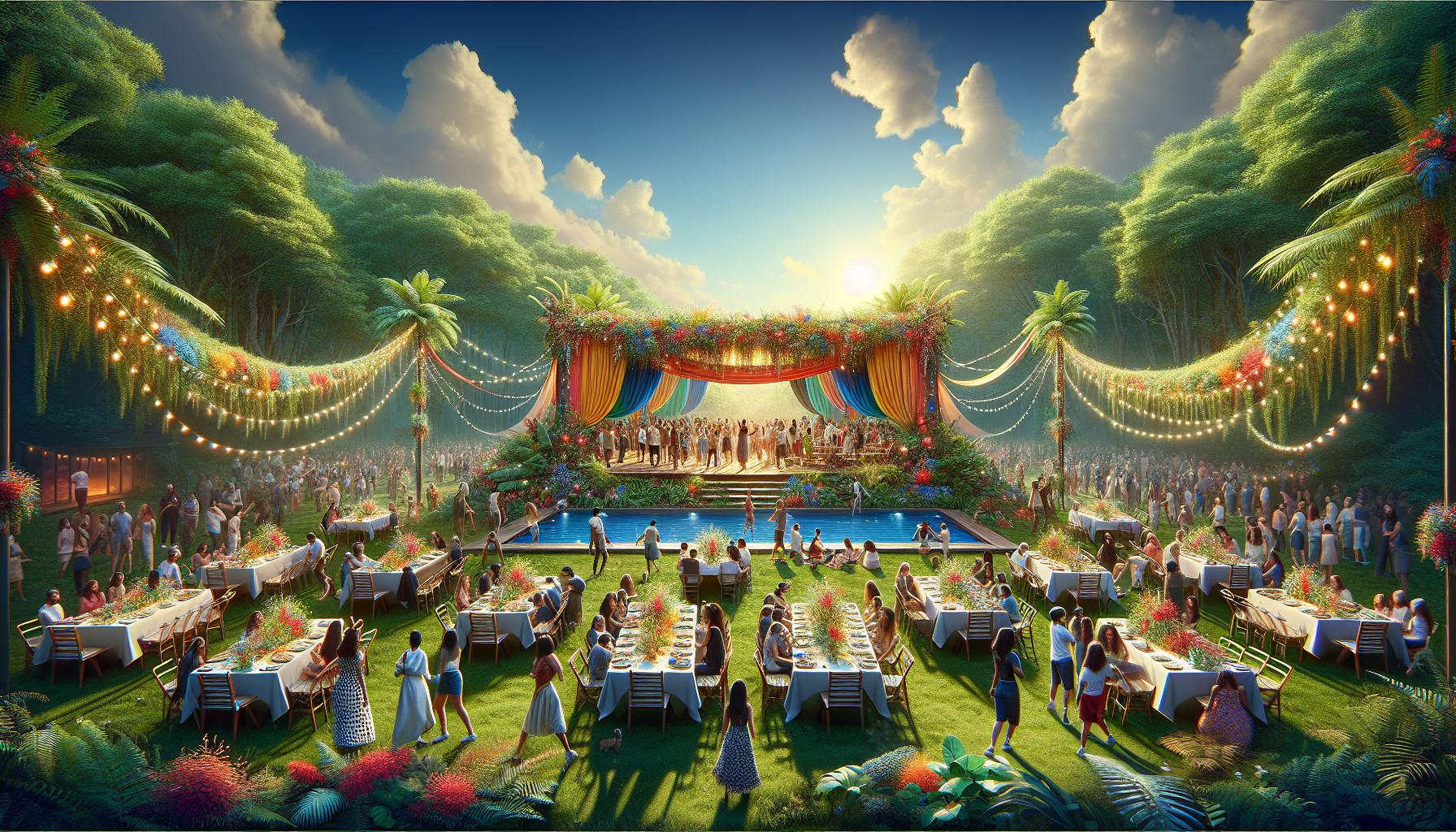Creating an eye-catching Facebook event cover photo can significantly impact attendance and engagement. The right dimensions ensure the image displays perfectly across all devices, from desktop computers to mobile phones.
Facebook’s event cover photo requirements have evolved over time as the platform continues to optimize user experience. Today, the platform recommends specific dimensions to ensure images appear crisp and professional without any awkward cropping or distortion. Understanding these specifications helps event organizers make a strong first impression and effectively promote their events on the world’s largest social media platform.
What Size Should a Facebook Event Cover Photo Be
Facebook event cover photos adhere to specific technical requirements that optimize display quality across devices. The platform’s image specifications ensure consistent visibility on desktop computers mobile devices.
Standard Dimensions for Event Cover Images
Facebook event cover photos maintain an aspect ratio of 1.91:1. The recommended dimensions are 1920 pixels wide by 1005 pixels high, creating a rectangular banner that spans the top of the event page. This size allows for clear visibility of essential event details without pixelation or distortion.
| Specification | Measurement |
|---|---|
| Width | 1920 pixels |
| Height | 1005 pixels |
| Aspect Ratio | 1.91:1 |
- JPEG files for photographs or complex images
- PNG files for graphics with text or logos
- GIF files for static images (animated GIFs unsupported)
| Size Limits | Specification |
|---|---|
| Minimum Size | 400 x 150 pixels |
| Maximum File Size | 30MB |
Optimizing Your Event Cover Photo

Facebook event cover photos require specific optimization techniques to maintain image quality across different devices and screen sizes. These optimization strategies ensure maximum visual impact while adhering to Facebook’s technical specifications.
Best Resolution Guidelines
High-resolution images at 1920 x 1005 pixels deliver optimal clarity on desktop displays. The image compression rate stays at 75-85% for JPEG files to balance quality with file size. Organizations utilize PNG format at 72 DPI for graphics containing text or logos to maintain crisp edges without pixelation.
Key optimization points:
- Export images in sRGB color profile
- Maintain 300 DPI for photographic content
- Compress files to under 20MB for faster loading
- Save final files with quality settings at 80%
- Apply moderate sharpening at 85-100% radius
Mobile-Friendly Considerations
Mobile devices display Facebook event cover photos at reduced dimensions of 640 x 335 pixels. The central 40% of the image remains visible on mobile screens without scrolling. Content placement focuses on the middle section to ensure critical elements appear on all devices.
- Center important text elements
- Leave 134-pixel padding on each side
- Test image legibility at 50% size
- Avoid small text under 16 pixels
- Position key visuals in the middle third
- Create contrast between text and background
| Device Type | Display Width | Display Height |
|---|---|---|
| Desktop | 1920 px | 1005 px |
| Tablet | 1200 px | 628 px |
| Mobile | 640 px | 335 px |
Common Design Issues to Avoid
Creating effective Facebook event cover photos requires avoiding critical design mistakes that impact visual appeal and functionality. Here’s how to prevent common issues that diminish the impact of event cover images.
Text Placement Tips
- Place text elements at least 100 pixels from the image edges to prevent cropping
- Center essential text between 440-880 pixels from the left edge
- Limit text overlays to 20% of the total image area
- Use fonts sized 30 pixels or larger for optimal readability
- Create contrast between text and background using solid color blocks or shadows
- Test text visibility at 640 x 335 pixels for mobile compatibility
- Export images at exactly 1920 x 1005 pixels to prevent automatic scaling
- Keep focal points within the safe zone (middle 60% of the image)
- Avoid placing logos or key visual elements near image borders
- Account for profile picture overlay in bottom left corner (180 x 180 pixels)
- Leave 140 pixels of clear space at bottom for event details
- Maintain symmetrical padding of 250 pixels on both sides of centered elements
The structured approach eliminates common pitfalls while ensuring cover photos display correctly across all devices.
How to Create the Perfect Event Cover Photo
Creating an effective Facebook event cover photo requires specific tools design techniques. The following guidelines ensure professional-looking results that meet Facebook’s requirements.
Recommended Design Tools
Professional design tools streamline the creation of Facebook event cover photos with precise dimensions templates.
Online Design Platforms:
- Canva offers pre-sized Facebook event templates with drag-drop functionality
- Adobe Express includes social media templates optimized for Facebook events
- Snapseed provides mobile-friendly editing capabilities for photos
- PicMonkey features custom dimension settings text overlay tools
Desktop Applications:
- Adobe Photoshop enables precise image manipulation color correction
- GIMP provides a free alternative with professional editing features
- Affinity Designer specializes in vector graphics logo creation
- Pixlr X offers browser-based editing with preset Facebook dimensions
- Creative Market supplies premium Facebook event templates
- Envato Elements provides subscription-based design assets
- Freepik offers free customizable social media templates
- Behance showcases professional Facebook event cover designs
| Design Tool | Key Features | Price Range |
|---|---|---|
| Canva | Pre-sized templates, drag-drop interface | Free – $12.99/month |
| Adobe Express | Brand kit integration, stock photos | Free – $9.99/month |
| Photoshop | Professional editing, layers | $20.99/month |
| GIMP | Full editing suite, plugins | Free |
- Design experience level
- Budget constraints
- Required features
- Time investment
Best Practices for Facebook Event Photos
Image Quality Guidelines
- Export photos in high resolution at 1920 x 1005 pixels
- Compress JPEG files between 75-85% quality
- Maintain 300 DPI for professional-grade photographs
- Keep file sizes under 20MB for optimal loading speed
- Use sRGB color profile for consistent display
Text and Design Elements
- Center critical text between 440-880 pixels from the left edge
- Leave 100-pixel padding from image borders
- Limit text overlays to 20% of total image area
- Use fonts sized 30 pixels or larger
- Create contrast ratios of 4.5:1 between text and background
- Include essential event details: date time venue name
Mobile Optimization
- Test visibility at 640 x 335 pixels (mobile display size)
- Position key elements in the center safe zone
- Avoid small text or intricate graphics
- Check readability on multiple device screens
- Ensure logos remain recognizable at reduced sizes
Composition Tips
- Place focal points within the middle 60% of the image
- Account for profile picture overlay in top left corner
- Use negative space strategically around text elements
- Create visual hierarchy with element sizing
- Include brand colors for consistent identity
- Maintain balanced element distribution
| Aspect | Requirement |
|---|---|
| Resolution | 1920 x 1005 px |
| Aspect Ratio | 1.91:1 |
| Minimum Size | 400 x 150 px |
| Maximum File Size | 30MB |
| Color Profile | sRGB |
| Safe Zone Width | 440-880 px |
| Text Coverage | ≤20% |
Creating the perfect Facebook event cover photo doesn’t have to be complicated. By sticking to the recommended dimensions of 1920 x 1005 pixels and following Facebook’s guidelines for text placement and image quality users can craft eye-catching visuals that work across all devices.
Whether using professional design software or user-friendly online tools the key is maintaining the correct aspect ratio while ensuring text remains readable. With these specifications in mind event organizers can focus on creating engaging designs that drive attendance and effectively promote their events.
Remember to test the cover photo on both desktop and mobile devices before publishing to guarantee the best possible presentation of your event.


More Stories
The Rise of De-Influencers: Challenging Consumerism on Social Media
The Psychology of Fantasy: Why People Love Adult Cam Sites
Faith and Connections: How Social Media Brings People Together